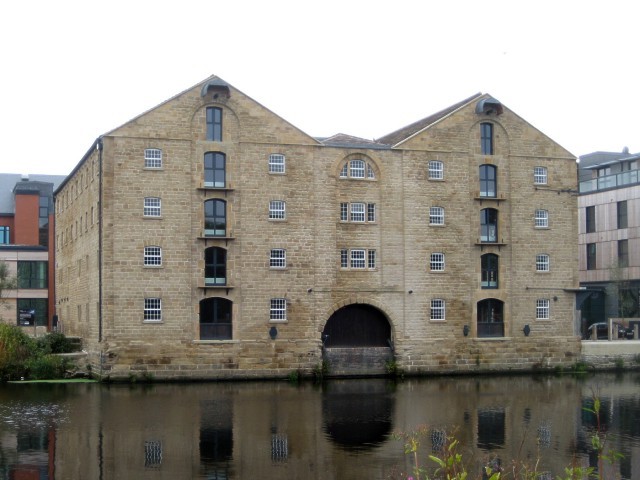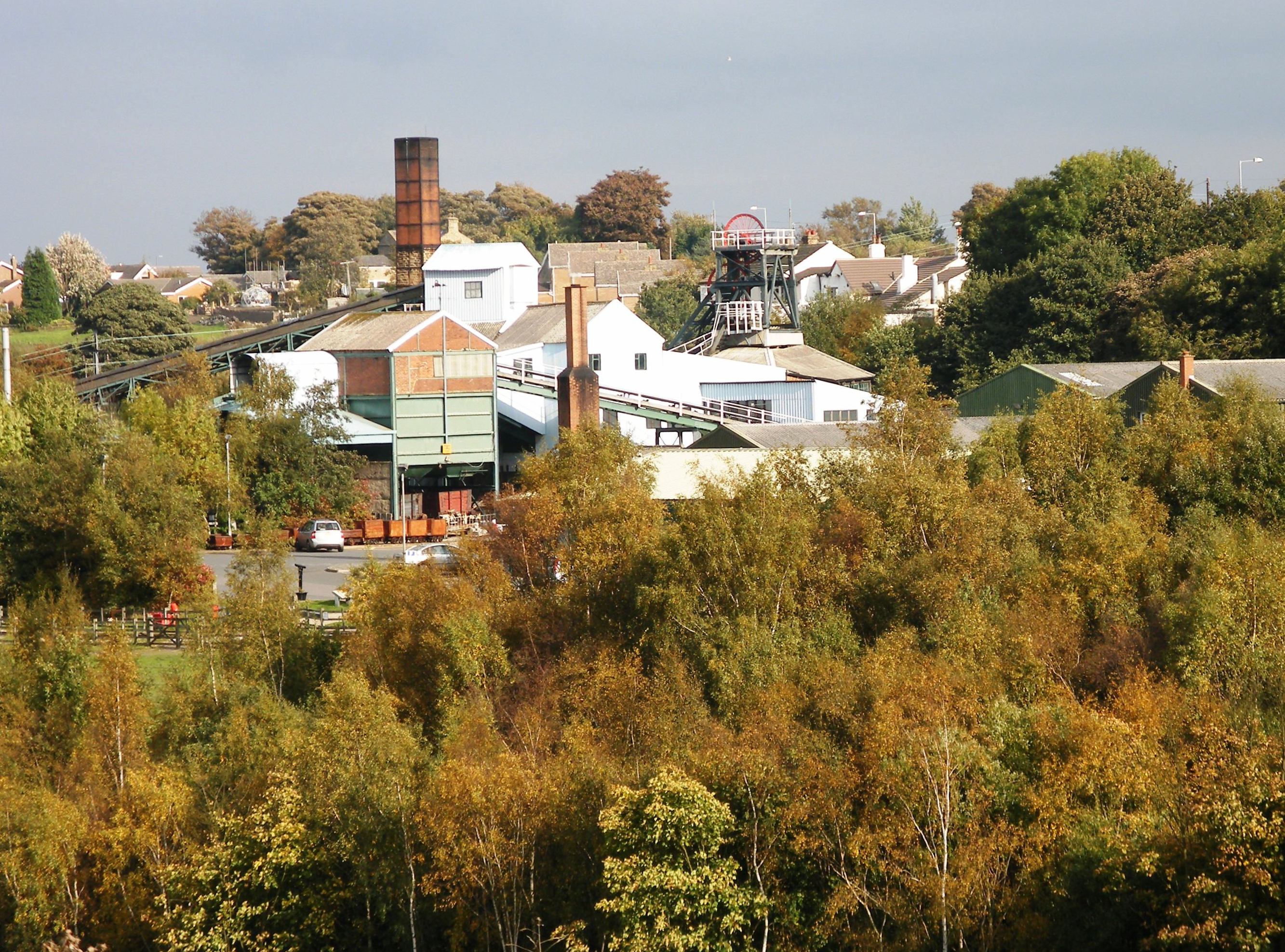Caphouse Colliery was a coal mine in OvertonAncient township of four villages, renamed from Shitlington to Sitlington in 1929., near Wakefield, West Yorkshire. It is about five miles (8 km) from Wakefield and seven from Huddersfield next to the A642 road. It was situated on the Lister Kaye family’s Denby GrangeEstate and mansion in Whitley Upper, between Huddersfield and Wakefield, in the West Riding of Yorkshire, seat of the lister Kaye baronets. estate where coal was worked from at least the 18th century.
Coal mining at Caphouse has a complicated history of ownership and name changes, it was connected with the Lister Kayes and various other owners until 1943, when it was sold and renamed Caphouse Colliery. It remained open in National Coal BoardStatutory corporation created to run the coal mining industry in the United Kingdom under the Coal Industry Nationalisation Act 1946. Statutory corporation created to run the coal mining industry in the United Kingdom under the Coal Industry Nationalisation Act 1946. ownership until 1985. It reopened as the Yorkshire Mining Museum in 1988, and is now the National Coal Mining Museum for England.
Background
Caphouse Colliery was sunk in an area where coal had been mined from shallow pits since 1515. Two shallow coal seams outcropped in the area, the Flockton Thin and the Flockton Thick. The Flockton Thick was worked by James Milnes who leased the mineral rights from Mary Wortley, the Countess of Bute in 1778. Milnes’ colliery had 17 shafts about 200 yards (183 m) apart by 1791 and was worked out by 1803. No. 17 shaft became the Caphouse shaft. Milnes also mined coal at Old Flockton. Some coal was sold locally, but much more was sent to distant markets to the east of Pontefract via the Calder and Hebble Navigation after Milnes’ pits were linked to the Calder and Hebble Navigation
Constructed between 1758 and 1834, the navigation makes the River Calder navigable between Sowerby Bridge and Wakefield in the West Riding of Yorkshire. at Horbury Bridge by the Flockton waggonwayFlockton Collieries comprised several pits, some started before 1700, around Flockton and Middlestown between Wakefield and Huddersfield in the West Riding of Yorkshire. .[1][2]
Timothy Smith leased the original Denby Grange Colliery north of neighbouring Flockton from Sir John Lister Kaye. Smith’s coal pits were under the control of Sir John Lister Kaye by 1817. When he died in 1827, his eldest son Sir John Lister Lister-Kaye took over.[2][3]
Overton Colliery
Sir John Lister Lister-Kaye took over the lease for getting coal at Overton from the executors of James Milnes in 1827. He renegotiated the lease with Lord Wharncliffe who had succeeded to the estates of the Countess of Bute. He employed John BlenkinsopMining engineer at Charles Brandling’s Middleton Collieries who patented a rack and pinion system for a steam locomotive and commissioned the first practical railway locomotive from Fenton, Murray and Wood’s Round Foundry in Holbeck, Leeds in 1811. of the Middleton Collieries as a consultant to oversee the enlargement of the enterprise.[3] Four shafts, the Blucher, Waterloo, Croft and Nelson on the site were deepened to the Flockton Thin and were known as the Denby Grange Colliery after the nearby seat of the Lister Kayes. The Wellington shaft by the side of the turnpike road was deepened in 1828 and became the colliery’s main winding shaft.
Hope Pit, 600 yards to the west, was sunk to the Old Hards seam and the Blossom Pit on the opposite side of the Wakefield to Austerlands turnpike road[a]now the A642 was sunk by 1840. Hope Pit’s shaft descends 215 yards (197 m) and produced coal after 1829. The coal was wound by horse gins until the 1920s.[4] The Inman Water Shaft was sunk to 97 yards (89 m) in about 1840 to pump water from Hope Pit, and its beam engine house survives.[5] The shaft was later deepened to the New Hards Seam. The pits were originally ventilated by furnaces at the shaft bottoms.[6]
In 1850 new leases were negotiated with Lord Wharncliffe and in 1853 Sir John started his own mineral line to give access to more distant markets. Kaye’s Mineral LineStandard gauge mineral line built to serve the pits owned by the Lister Kayes of Denby Grange in West Yorkshire. opened in 1854, an unusual line, it used both rope and locomotive haulage to connect Caphouse to sidings by the Lancashire and Yorkshire’s Barnsley branch line and to staithes on the navigation at Calder Grove.[2]
The colliery was again developed in 1876 when the steam winding engine house, boiler yard, chimney, stone heapstead and ventilation shaft were completed for Emma Lister-KayeColliery owner in Overton near Wakefield in the West Riding of Yorkshire from 1871 until 1905. , the sole proprietor who had inherited the colliery from her father in 1871.[7] She had the Caphouse shaft deepened to the New Hards seam at 141 yards (129 m). The winding engine was bought second-hand and power was supplied by two Lancashire boilers.[8] The headframe is built of pitch pine with steel braces, a late survivor of its type. The Caphouse shaft is 11 feet (3.4 m) in diameter, and although it had been deepened and widened, may have been the oldest working mine shaft in the country in the 1980s.[4]
The New Hards seam was worked out at the Hope and Blossom Pits in 1885. Blossom Pit closed and Hope Pit was deepened to the Wheatley Lime seam at 129 yards (118 m).[8] Hope Pit and Caphouse were not connected until a roadway was driven through the fault that separated their workings in 1887. All coal was subsequently wound to the surface at the Caphouse shaft and a ventilation fan was fitted at the Hope shaft.[8]
In 1892 colliers were paid 4/6d. per day and 13/6d. in 1938.[9] In 1901 the colliery employed 93 workers and this total rose to 206 in 1911, and 240 in 1918.[10]
After Emma Lister-Kaye’s death in 1905, the Denby Grange Collieries, comprised of Caphouse and the Prince of Wales Colliery (locally known as Wood Pit) near Midgley, were managed by her executors. Percy Greaves, the manager, introduced machinery to undercut the coal by 1911. Greaves bought the colliery in 1917 and in 1922 his company was incorporated as Denby Grange Collieries Ltd. It had a workforce of 840 men. The company became Terry, Greaves and Lister-Kaye in 1928.[11] The pit
Pithead baths for 300 men and an administration block were built around 1937.[4] Caphouse Colliery was separated from the Prince of Wales and sold to Lockwood and Elliott who were working Shuttle Eye CollieryColliery on the South Yorkshire Coalfield at Grange Moor in West Yorkshire, between Wakefield and Huddersfield on the A642 road. in 1943. The new company set about developing the Beeston seam via an inclined drift and the deepened Hope shaft. All coal was then moved out by road.[11]
The colliery became part of the National Coal BoardStatutory corporation created to run the coal mining industry in the United Kingdom under the Coal Industry Nationalisation Act 1946. Statutory corporation created to run the coal mining industry in the United Kingdom under the Coal Industry Nationalisation Act 1946. on nationalisation in 1947. The NCB replaced the back legs of the pitch pine headgear with rolled steel.[11] In 1960 an electric ventilation fan was installed at the Hope shaft, and after unsuccessful experiments with mechanising underground production using coal ploughs, mechanical shearers were introduced in the Beeston seam.[12]
A surface drift to the Beeston seam opened in 1974 and winding coal ceased at the Caphouse shaft which was then used for pumping and ventilation.[12] In 1978 the colliery employed 230 men winning 4,000 tons of coal per week from the Beeston seam.[4] In 1981 the colliery was linked to the Prince of Wales Pit, by now named Denby Grange, by two 1¾ mile (2.8 km) underground roadways. In 1982 the Hope, and Caphouse shafts and the Caphouse drifts all became downcasts for Denby Grange Colliery and the winding engine was removed. In October 1981, the Caphouse workforce, 270 men, was transferred to the Denby Grange books.[13]
The Yorkshire Mining Museum trust was set up in 1983 and Caphouse opened as the Yorkshire Mining Museum in 1988.[5] The museum gained national status as the National Coal Mining Museum for England in 1995.[13]


